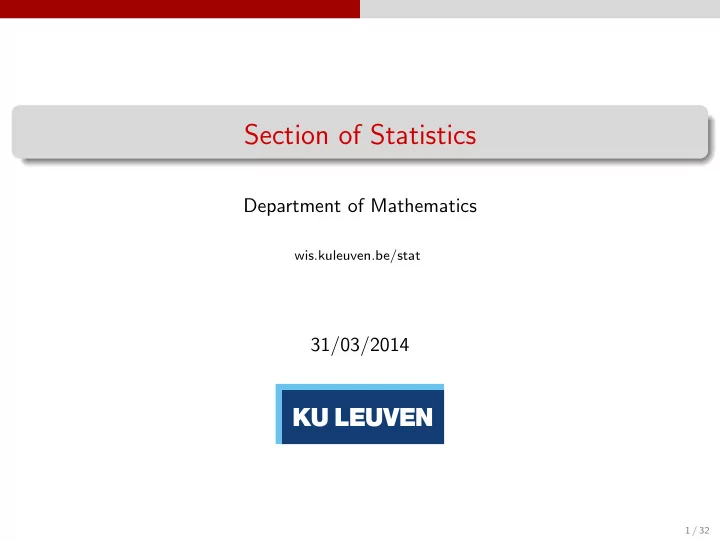

Section of Statistics Department of Mathematics wis.kuleuven.be/stat 31/03/2014 1 / 32
Outline Outline General information about research, courses, theses 1 Information about each research group 2 Questions 3 2 / 32
General info Three major research themes: Nonparametric Robust and and semiparametric computational statistics statistics Financial mathematics and actuarial statistics 3 / 32
General info Courses offered by our section We offer courses within the Master of Mathematics 1 Master of Statistics 2 Master of Financial and Actuarial Engineering 3 4 / 32
General info Master of Mathematics - Option Applied Mathematics Core courses: Advanced statistical inference (S. Van Aelst) 1 In this course modern statistical models and procedures such as e.g. resampling techniques (bootstrap, jackknife), robust statistical methodology, nonparametric association measures, censoring and survival analysis are introduced. The practical use of these methods will be discussed as well. Stochastic models (J. De Spiegeleer) 2 Becoming familiar with stochastic modelling of dependent stochastic variables, practicing examples of stochastic models. Statistische modellen en data-analyse (M. Hubert) 3 From the bachelor Mathematics, can still be chosen. In deze cursus worden de voornaamste multivariate statistische modellen bestudeerd, alsook de methoden om hiermee multivariate gegevens te analyseren. Er wordt vooral aandacht besteed aan de praktische aspecten bij de analyse van concrete data-voorbeelden. 5 / 32
General info Master of Mathematics - Option Applied Mathematics In-depth courses: Advanced nonparametric statistics (I. Gijbels) [2014-2015] 1 Robust statistics (P. Rousseeuw, M. Hubert) [2015-2016] 2 Statistics of extremes (J. Beirlant) [probably 2015-2016] 3 Statistics for finance and insurance (T. Verdonck) 4 Selected topics in Mathematics (D. Paindaveine, ULB) [2014-2015] 5 Fundamentals of financial mathematics (W. Schoutens, P. Leoni) 6 Financial engineering (W. Schoutens, P. Leoni) 7 6 / 32
General info Master thesis Diversity of topics, all driven by a real world problem. A typical thesis contains theoretical and applied parts. Their relative weight is flexible to some extent. Theoretical parts: literature review, study of theoretical properties, working out proofs. Applied parts: simulation study to verify theoretical properties and to study finite-sample behavior, real data analysis, use of R/Matlab, some programming. 7 / 32
Research groups Outline General information about research, courses, theses 1 Information from each research group 2 Questions 3 8 / 32
Research groups Nonparametric and semiparametric statistics Nonparametric and semiparametric statistics Key research topics: flexible regression models and modeling of complex data variable selection and sparse estimation methods investigating dependencies (conditional and unconditional) via copulas; modeling the dependence dynamics statistical analysis of functional data: core probabilistic and statistical concepts and properties 9 / 32
Research groups Nonparametric and semiparametric statistics Examples 0.8 40 0.6 30 0.4 Y2 Y2 20 0.2 10 0.0 0 0 5 10 15 20 25 0.0 0.5 1.0 1.5 2.0 2.5 3.0 Y1 Y1 Kendall’s tau = 0.667 same dependence structure; different marginals estimation of the dependence structure via copulas , two or more dimensions 10 / 32
Research groups Nonparametric and semiparametric statistics Examples modeling the dynamics of a dependence structure observations (hourly measurements) of wind speeds at two (or more) weather stations 50 60 40 50 hourly average wind speed in mph hourly average wind speed in mph 40 30 30 20 20 10 10 0 0 Apr Mai Jun Jul Apr Mai Jun Jul Kennewick − 2013 Butler Grade − 2013 forecast the wind speed in the region looking at both time series jointly other related topics: portfolio selection in financial applications, study of the value-at-risk 11 / 32
Research groups Nonparametric and semiparametric statistics Examples flexible regression modeling and variable selection predict the level of atmospheric ozone concentration from daily meteorological measurements determine important pollutants, and their effects data data P−splines P−splines functional contribution of humidity OLS OLS functional contribution of temp 30 30 20 20 10 10 0 0 20 40 60 80 30 40 50 60 70 80 90 humidity temp 12 / 32
Recommend
More recommend